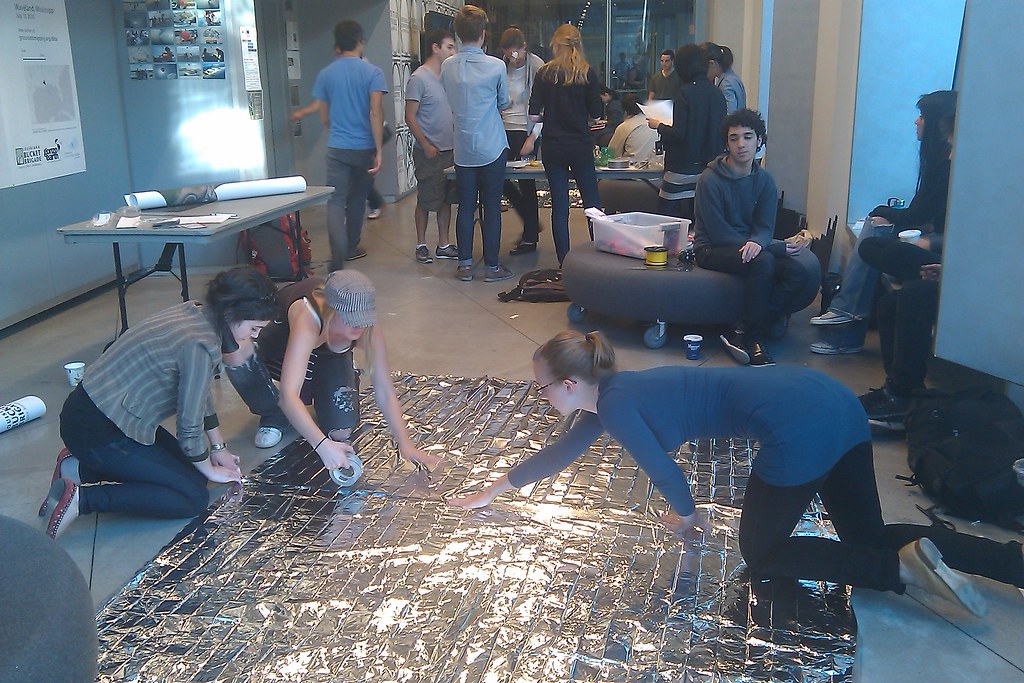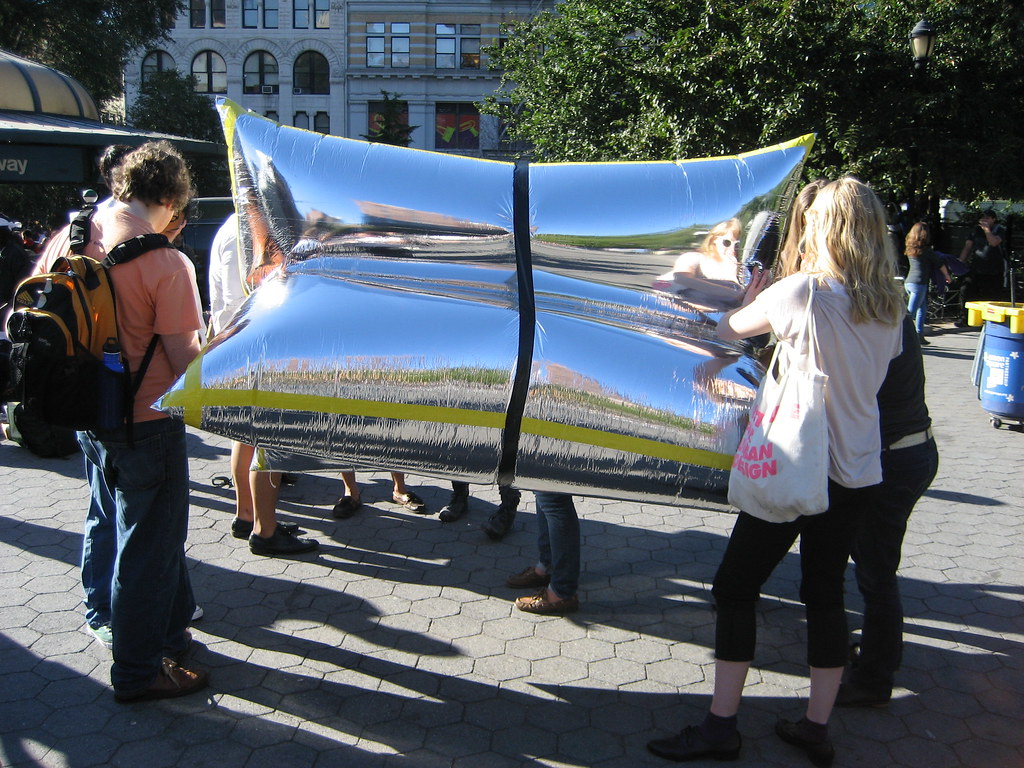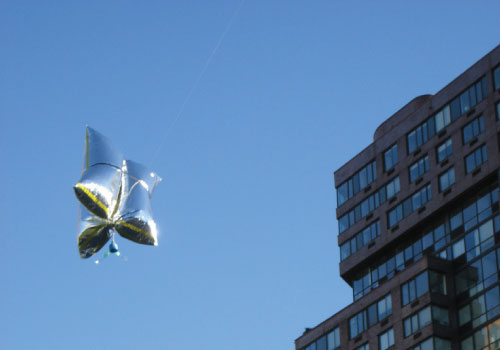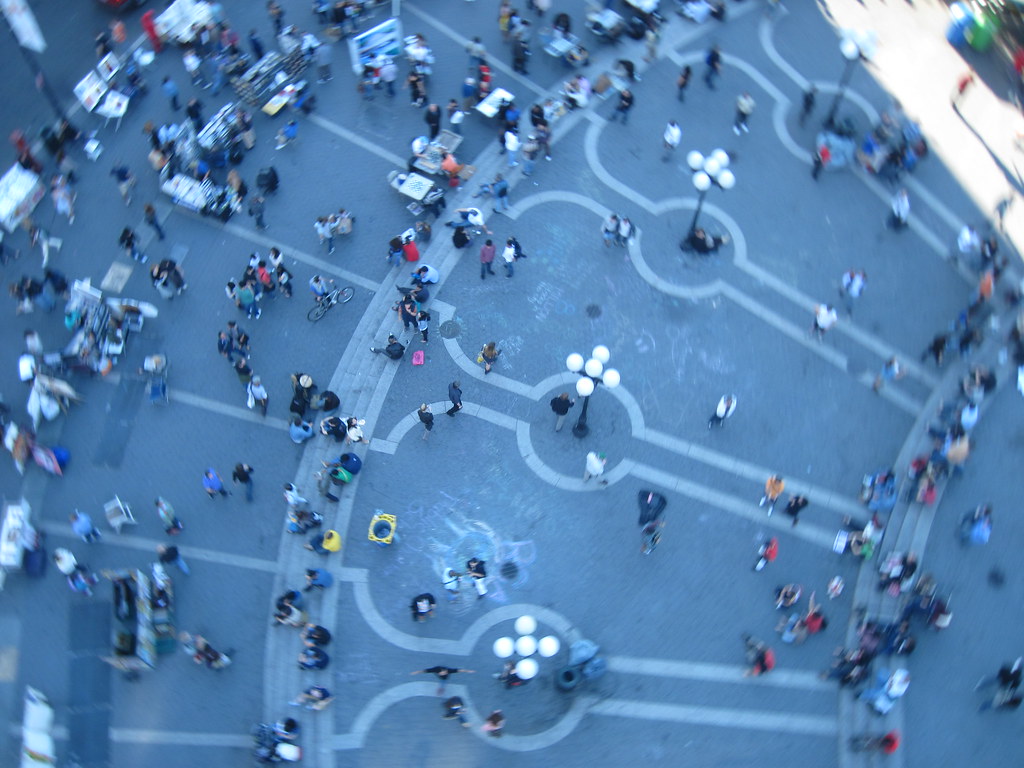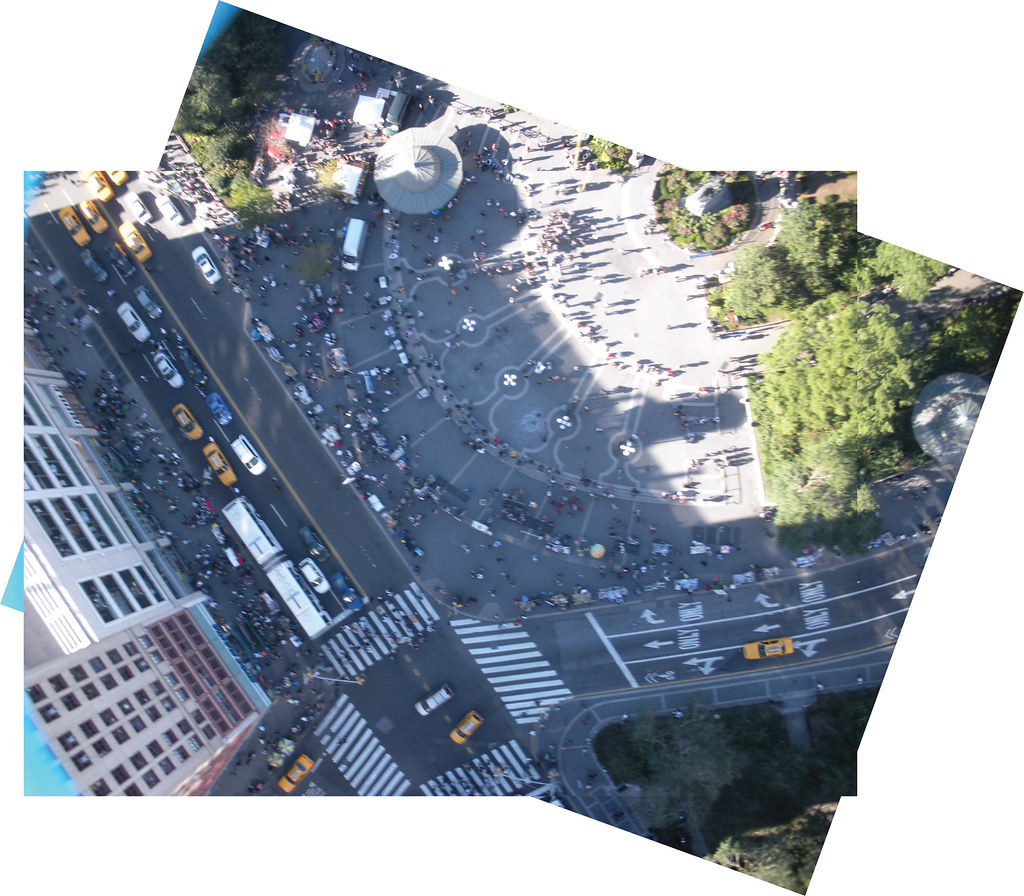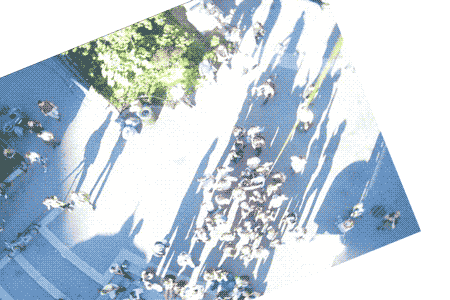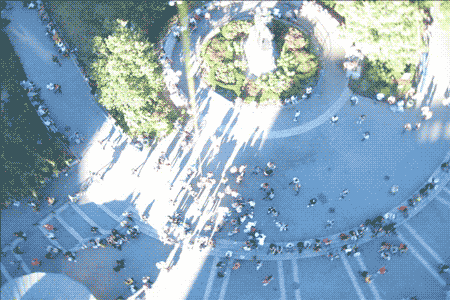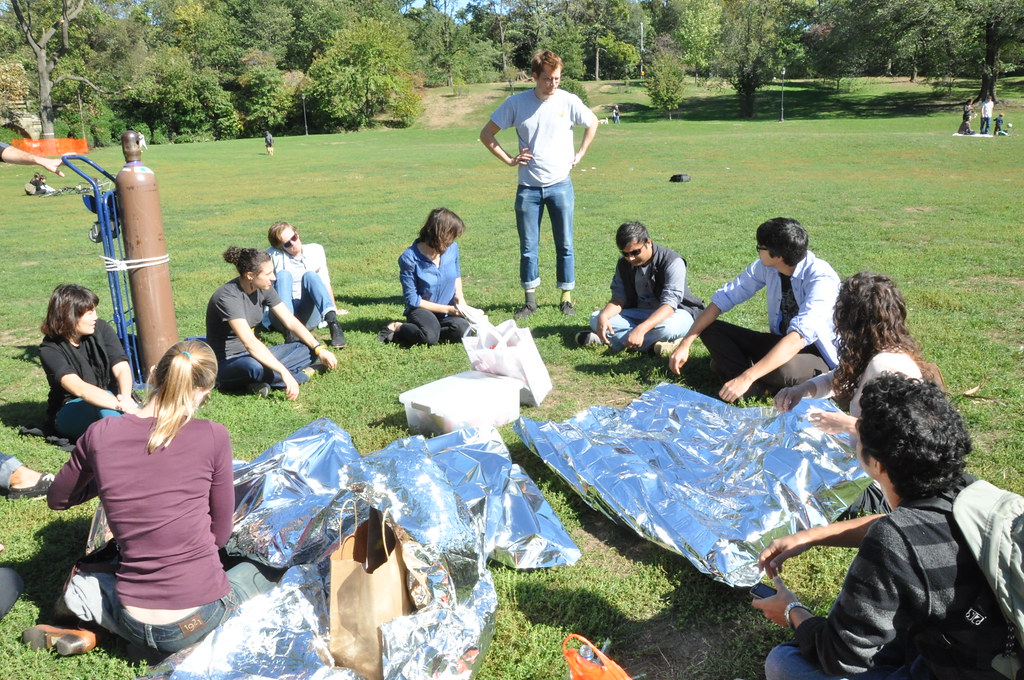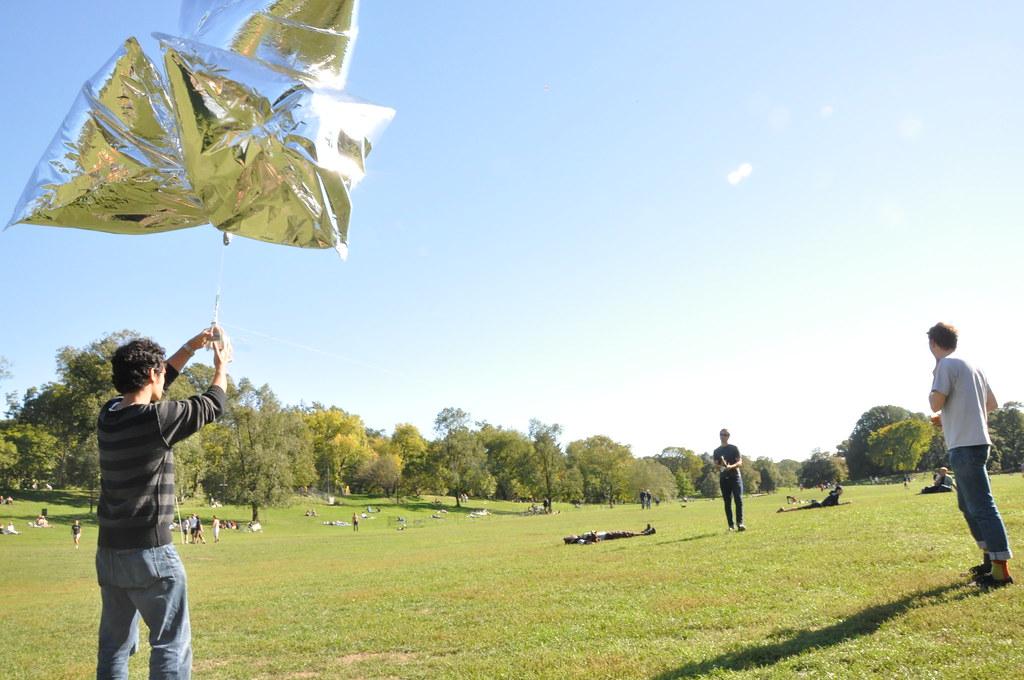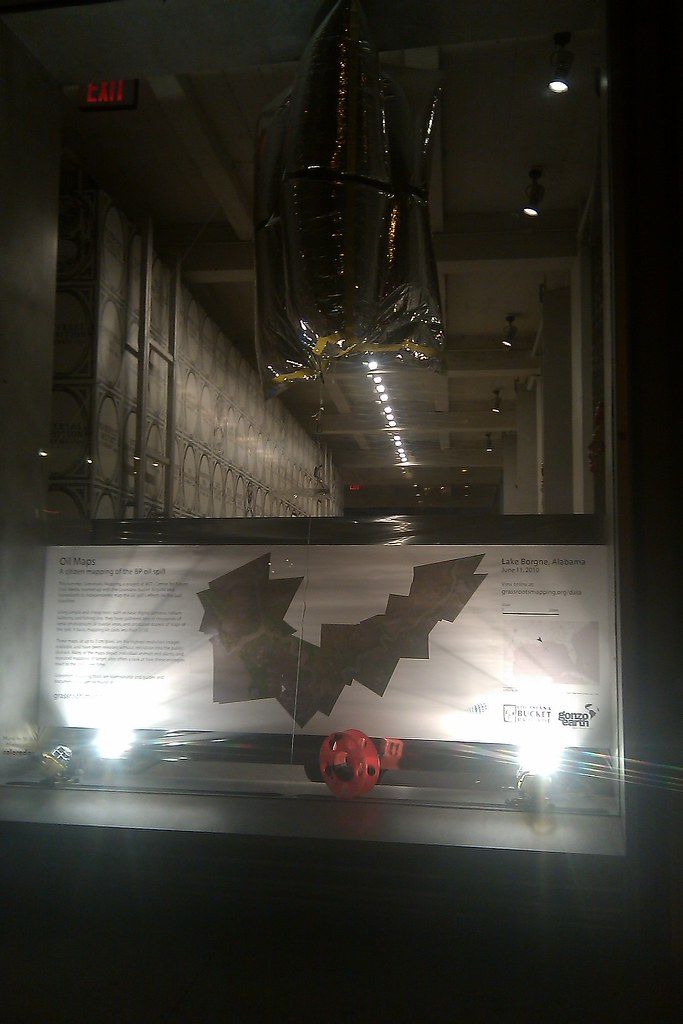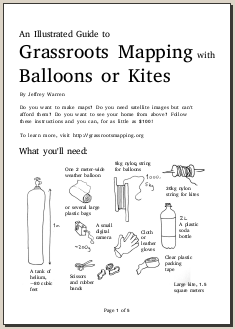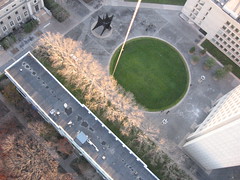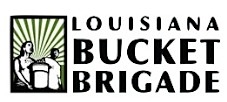NYC report back on UMOs*
October 18th, 2010 by Liz Barry* UMO = “unidentified mapping object”
On the morning of Friday October 8th, the Grassroots Mapping public workshop kicked off in the corner gallery on 5th avenue and W 13th Street. We began experimenting with a few types of mylar ranging from 55″ 1 mil rolls to 0.5 mil emergency survival sleep sacks, in shapes ranging from a tetrahedron to what some referred to as the “burrito.” Seams were folded and taped, then pressed with a pen or ID card. We worked all day to assemble four rigs between the two dedicated Parsons/Eugene Lang classes and bring together materials for the exhibit and for Saturday’s workshop. Fun fact: New York taxis will not pick up a 5 foot tall tank of helium.
On Saturday morning, around 40 people headed out to the southern plaza at Union Square– the plaza was crowded with guitar soloists, hacky sack tribes, art vendors, skateboarders, “Free Hugs” poster-bearers and speed chess players, who were enjoying the unusually warm weather. The students from Parsons and Eugene Lang were joined by members of NYU’s Public Health department, Harvard’s Graduate School of Design and interested passers-by. Our balloon strategy was initially thwarted by the high wind speeds and turbulence around the buildings, a situation which caused a delay since we did not have enough room to fly a kite. After a while, the wind calmed down and we could proceed with inflating our mylar structures. Persistent near-ground turbulence was adversely affecting flight, so we needed to add more lifting power to rise quickly above the height of the buildings. The team continued to inflate and attach more mylar structures until finally arriving at a very stable design of three factory-sealed sleep sacks belted with duct tape.
At this point, we tied a loop in the 40lb braided Spectra, clipped on the rig and turned on the camera. The first thing we noticed was that the extended lens was not adequately protected by the soda bottle, so we immediately unclipped the rig to modify the housing. Then we sent the rig up a hundred feet or so. The wind was really moving the camera rig around, which resulted in blurry images. We pulled it down and doubled the length of the fins in an attempt to make the rig more stable.
The modifications to the rig worked well and the balloon floated to the other side of the plaza and across the street capturing imagery. A gust of wind pushed it rapidly along the side of a 20 story brick building and around the back corner. After a minute, it freed itself on a cross breeze, traveled across the street and promptly got caught on a terrace. Although it did free itself a second time, there was a lot of wear and tear on the relatively light line, but luckily it did not break (yet).
We were interested in the social activities happening in Union Square in Manhattan and Prospect Park in Brooklyn. Performers, chalk artists, impromptu existential debaters, BMX stunt-riders (among others) were all variously re-routing or attracting the hordes of pedestrians streaming along 14th Street and around the subway entrances.
Later in the afternoon the wind died down, and we were able to tether the rig close to the ground and capture group photos in the midst of the busy plaza with dramatic shadows cast by the low solar angle. Animated gifs assembled by Colin McFayden [macfc418 at newschool dot edu]:
This wrapped up Saturday’s workshop, and we retired to ramen noodles on University to restore ourselves.
Bright and early Sunday morning, Alexandra Barker of Pratt Institute loaded up the helium tank (although only half full, it was not any lighter) into the station wagon and drove over to Grand Army Plaza. We were met by a dozen Pratt graduate architecture students on bikes, and we headed into Prospect Park’s Great Meadow with our supplies.
In the previous class, we had constructed our tetrahedrons from the roll of 55″ mylar, which meant that we had to seal and reinforce three sides. As compared to an emergency blanket which only requires closing one side, each tetrahedron took more time to assemble, held a greater volume of helium, but also leaked more gas.
In retrospect, we should have realized that the line which had been dragged around building corners in Union Square the day before would be compromised. Yet we were stunned when the line broke around 400′ out, and the three mylar structures floated off with Jeff’s camera and Liz’s name / contact info written on the fin. We are still hoping that the mylar and rig will be recovered. In the meantime, we are crossing our fingers that it does not end up in a waterway. We moved on to flying kites on the expansive lawn, but a few days later there was a sighting that made us wonder:
Daily News films three unidentified airborne objects
There are other possible explanations for the sightings including a helium balloon give-away in Times Square and a bunch of opalescent balloons that were accidentally released in Westchester.
Photos of the exhibit at Parsons, 66 5th Avenue / 2 West 13th Street:
Along 13th Street: stitched maps of the BP Oil Spill created by the Louisiana Bucket Brigade and Gonzo Earth.
5th Avenue at the corner of 13th Street: a stitched map of the BP Oil Spill (expansive blue-green wetlands, dwarfing the tiny piece of orange oil-absorbing boom) created by the Louisiana Bucket Brigade and Gonzo Earth, along with the rig and mylar structures we used in Union Square and some dramatic lighting.
The exhibit and events are sponsored by Urban Inclusions, a collaboration between Urban Design at Parsons the New School for Design and Urban Studies at Eugene Lang College. Additional thanks to the students of Mapping the City, Street Life, and Critical Geography.
Tags: events

